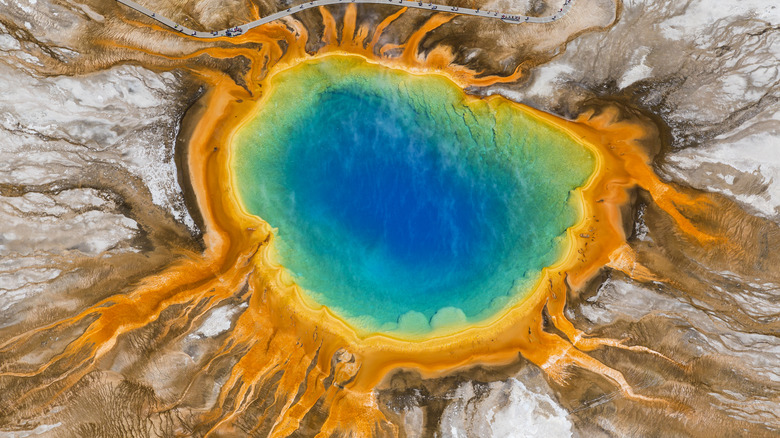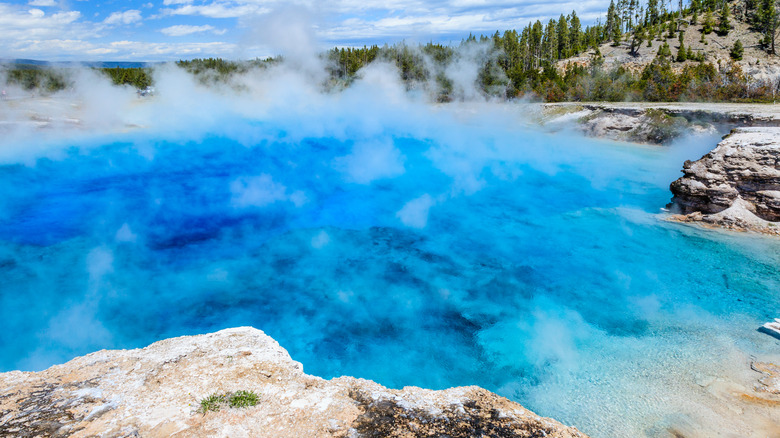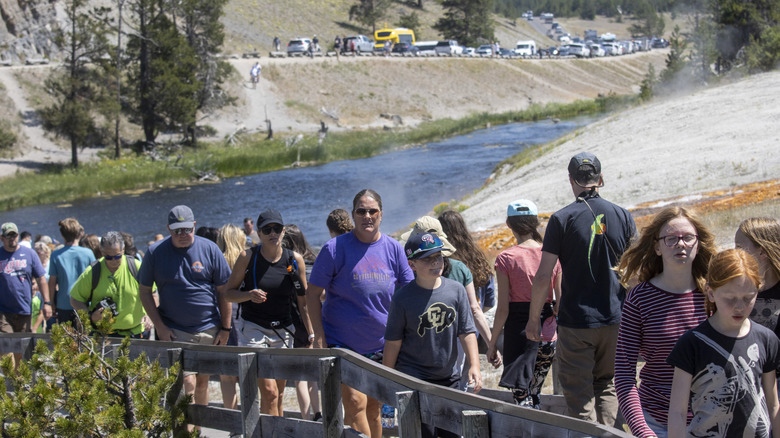North Of Old Faithful Is A Vibrant Geyser Basin With A Unique Ecological Environment
The geysers, mud pots, and hot springs of Yellowstone National Park have attracted countless tourists for the better part of 150 years. The chance to see Earth's raw geothermal power up close is pretty special. From Old Faithful to the lesser-known (but bigger!) Steamboat Geyser in the park's Norris Geyser Basin, Yellowstone is perhaps the best place in the world to see and learn about these hydrothermal wonders. That's because a full 60% of the world's geysers and hot springs are located within Yellowstone's borders. There are about 10,000 documented hydrothermal features in the park — it would be impossible for visitors to see them all. However, one easily accessible geyser basin just north of Old Faithful offers visitors a chance to see some of Yellowstone's most dramatic geothermal landscapes.
Midway Geyser Basin is located 7.5 miles north on the Grand Loop Road from the Old Faithful complex. And, just like any noteworthy feature in the park, the crowds can get pretty thick during the summer months. But don't let a long line get in the way of seeing a couple of Yellowstone's most inspiring hydrothermal features. Both the Grand Prismatic Spring and the now-dormant Excelsior Geyser are located at Midway, and by following a few simple rules to avoid some upsetting tourist mistakes, visitors can experience these features in all their glory.
A colorful spring and a massive dormant geyser
Grand Prismatic Spring is a must-see hydrothermal feature for tourists visiting Yellowstone National Park. It's the largest hot spring in Yellowstone, and its brilliant, colorful countenance has inspired visitors for generations. Its temperature ranges from 145 degrees Fahrenheit to a piping-hot 188 degrees. That may not seem terribly hot, but remember one thing: At Yellowstone's elevation of about 8,000 feet, water boils at 199 degrees, not the standard 212 degrees. Grand Prismatic is a staggering 370 feet in diameter — tourists following the signs on the Midway boardwalk can't miss it.
While Grand Prismatic is visually stunning, another Midway feature might be even more mysterious. The dormant Excelsior Geyser was an active and massive geyser as recently as 1985, but it hasn't erupted since. Today, it's not considered a geyser at all — like Grand Prismatic, it's considered by the park's hydrologists to be a hot spring. In its heyday, Excelsior was the biggest geyser in the world — its hot-water spray would shoot 300 feet into the Wyoming sky. Now, it's a gorgeous, deep blue crater laden with 199-degree water. That makes it one of the hottest surface springs in Yellowstone.
Tips to see Midway Geyser Basin without the crowds
As noted, Yellowstone National Park is adored by visitors. By the end of October 2024, more than 4.6 million visitors entered the park through its five entrances. The throngs of tourists can be off-putting — nobody wants to stand three people deep just to get a look at the stunning azure waters of Grand Prismatic Spring.
But there are ways to beat the crowds; here's some advice. Arrive early. The park's entrance gates remain open throughout the operating season, which runs from late April to early November, weather permitting. So, even if an entrance station isn't crewed by a National Park Service ranger, visitors can still drive into the park. By arriving early — like right around dawn — visitors can find a parking spot at Midway Geyser basin and walk the short boardwalk to both Grand Prismatic Spring and Excelsior Geyser in relative solitude.
Not an early riser? Instead of getting up at the crack, consider coming during the "off-season" or before the Memorial Day weekend in May and after the Labor Day weekend in early September (all considered the best times of the year to visit the park). Following this advice applies to all the park's dramatic features, including Old Faithful and the breathtaking Grand Canyon of the Yellowstone. Regardless of the season, Yellowstone is an inspiring destination. Seeing it, even with crowds of other tourists, is better than never seeing it all.


